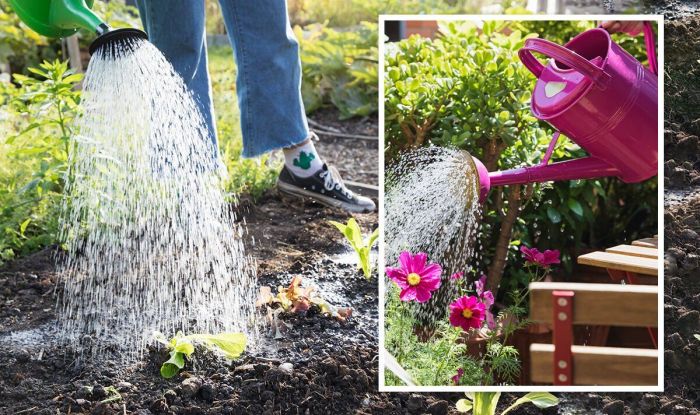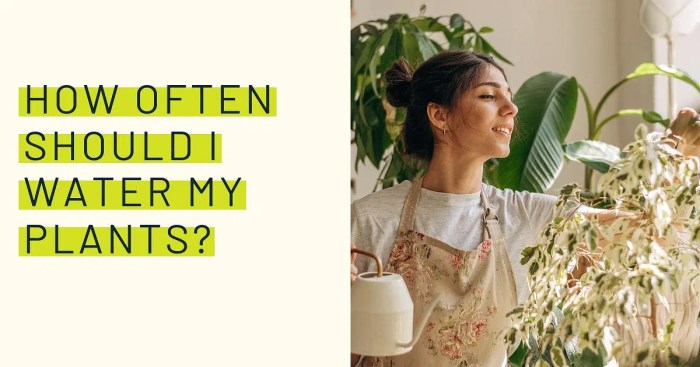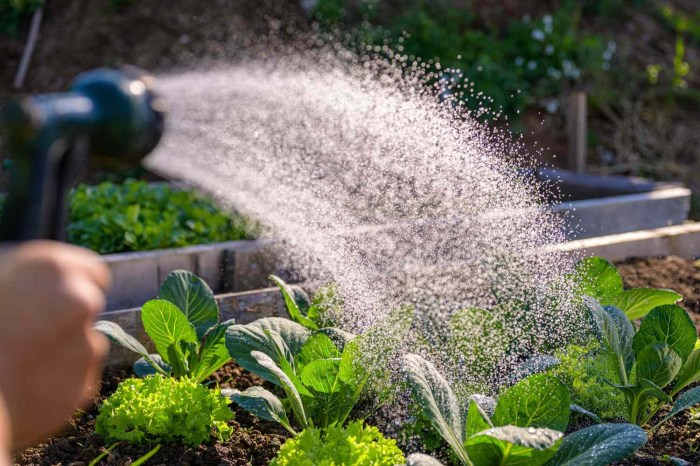How Often to Water Plants A Comprehensive Guide
Factors Influencing Watering Frequency
How often to water plants – The frequency with which you water your plants depends on several interacting factors. Understanding these factors is crucial for maintaining healthy and thriving plants. Ignoring these factors can lead to both underwatering and overwatering, both detrimental to plant health.
Plant Type and Water Requirements
Different plants have vastly different water needs. Some thrive in consistently moist soil, while others prefer drier conditions. This table categorizes plants based on their water requirements, soil preferences, and suggested watering frequencies.
| Plant Type | Water Needs | Soil Type Preference | Watering Frequency |
|---|---|---|---|
| Snake Plant (Sansevieria trifasciata) | Low | Well-draining | Once every 2-3 weeks |
| Peace Lily (Spathiphyllum) | Medium | Moist, well-draining | Once a week, or when the top inch of soil is dry |
| African Violet (Saintpaulia ionantha) | Medium-High | Well-draining, slightly acidic | Every 3-5 days, keeping soil consistently moist but not soggy |
| Philodendron | Medium | Well-draining potting mix | Once a week, allow top inch to dry slightly between waterings |
| Pothos (Epipremnum aureum) | Medium | Well-draining potting mix | Once a week, allow top inch to dry slightly between waterings |
Pot Size and Material
The size and material of the pot significantly influence how quickly the soil dries out. Larger pots retain moisture longer than smaller pots, and different materials have varying porosity.
- Terracotta pots: These are porous and allow for faster evaporation, requiring more frequent watering, especially in smaller sizes. A small terracotta pot might need watering daily in hot weather, while a large one might only need it every other day.
- Plastic pots: These are less porous, retaining moisture for longer periods. A small plastic pot might need watering every 2-3 days, while a large one could go a week or more between waterings.
Environmental Conditions
Temperature, humidity, and sunlight all affect how quickly soil dries out. Higher temperatures and increased sunlight accelerate evaporation, leading to more frequent watering needs. High humidity can slow down drying, reducing the need for frequent watering.
The following flowchart illustrates the relationship:
Flowchart:
High Temperature/Sunlight → Increased Evaporation → Soil Dries Faster → More Frequent Watering
High Humidity → Decreased Evaporation → Soil Dries Slower → Less Frequent Watering
Low Temperature/Sunlight → Decreased Evaporation → Soil Dries Slower → Less Frequent Watering
Soil Type and Water Retention
Different soil types have varying water retention capacities. Sandy soils drain quickly, requiring more frequent watering, while clay soils retain water for longer periods, potentially leading to overwatering if not carefully monitored. Loamy soil offers a good balance.
- Sandy soil: Dries quickly, needs frequent watering.
- Loamy soil: Retains moisture well, but drains adequately.
- Clay soil: Retains water for a long time, prone to overwatering.
Recognizing Signs of Underwatering and Overwatering

Source: co.uk
Understanding the visual cues of both underwatering and overwatering is crucial for maintaining healthy plants. Accurate diagnosis allows for timely corrective action.
Signs of Underwatering
Underwatered plants exhibit several tell-tale signs. These include wilting, dry soil, and leaf browning. The severity of these symptoms depends on the duration and extent of the underwatering.
Image Description 1 (Wilting): A picture of a wilting plant, showing droopy leaves and stems. The soil is visibly dry and cracked. This indicates a lack of sufficient water reaching the plant, causing the leaves to lose turgor pressure.
Image Description 2 (Dry Soil): A close-up image of dry, cracked soil in a pot. The soil is light brown and lacks moisture. This is a clear indication of underwatering, and the plant will likely show signs of stress soon.
Signs of Overwatering
Overwatering is equally detrimental to plant health. It can lead to root rot and other issues. The following list details common symptoms.
- Yellowing leaves
- Drooping leaves (different from underwatering droop)
- Soggy soil
- Foul-smelling soil
- Leaf drop
- Stunted growth
Comparing Underwatering and Overwatering Symptoms, How often to water plants
While both underwatering and overwatering cause wilting, the accompanying symptoms differ significantly. Underwatering leads to dry soil and crispy leaves, while overwatering results in soggy soil and yellowing leaves. Careful observation of these differences is crucial for accurate diagnosis.
Watering Techniques and Methods
Several watering methods exist, each with advantages and disadvantages. Selecting the most appropriate method depends on the plant type, pot size, and personal preference.
Watering Methods
| Watering Method | Advantages | Disadvantages |
|---|---|---|
| Top Watering | Simple, convenient, good for most plants | Can lead to surface crusting, may not reach all roots |
| Bottom Watering | Allows for even moisture distribution, reduces risk of surface crusting | Slower, requires a tray or saucer |
| Soaking | Thoroughly saturates the soil, ideal for certain plants | Can be messy, may lead to overwatering if not done carefully |
Proper Watering Depth and Frequency

Source: gumlet.io
Watering depth and frequency are critical. It’s essential to water deeply enough to reach the roots but avoid overwatering. Checking soil moisture before watering helps prevent both underwatering and overwatering.
Diagram Description: A diagram showing a person using their finger to check the moisture level of the soil. The diagram shows the soil at different moisture levels (dry, slightly moist, and wet) and the corresponding depth of finger insertion. The image indicates that if the soil is dry up to the second knuckle, it’s time to water.
Creating a Self-Watering System
A self-watering system provides consistent moisture to plants, reducing the need for frequent watering. This can be particularly beneficial for busy individuals or during vacations.
Step-by-Step Guide (Illustrative):
1. Gather materials: A large container, smaller pots, wicking material (e.g., cotton rope), and soil.
2. Prepare the reservoir: Place the smaller pots inside the large container.
3.
Insert wicks: Run the wicking material from the bottom of the smaller pots into the water reservoir.
4. Fill the reservoir: Add water to the reservoir, ensuring the wicks are submerged.
5. Plant and water: Plant your plants and water thoroughly initially.
Proper watering is crucial for plant health; the frequency depends on factors like plant type, pot size, and environment. This differs significantly from aquatic plants, as you’ll discover when researching what plants are good for salt-water aquarium , where water management is entirely different. Returning to terrestrial plants, remember to check soil moisture before watering to avoid overwatering, a common cause of plant decline.
The wicks will then draw water from the reservoir as needed. Regularly check the water level in the reservoir.
Developing a Personalized Watering Schedule
Creating a personalized watering schedule ensures your plants receive the appropriate amount of water. This schedule should be tailored to the specific needs of each plant.
Personalized Watering Schedule Template

Source: trimmedroots.com
This template allows you to track watering dates and observe plant health.
Template:
Plant Name: _______________
Plant Type: _______________
Pot Size: _______________
Pot Material: _______________
Soil Type: _______________
Watering Frequency: _______________
Date | Watering Amount | Notes (e.g., leaf condition, soil moisture)
—|—|—
Adjusting for Seasonal Changes
Watering schedules should be adjusted based on seasonal changes. During hotter months, plants require more frequent watering, while during cooler months, the frequency can be reduced.
Moisture Monitoring Tools
Moisture meters provide an objective assessment of soil moisture. These tools eliminate guesswork, helping to prevent both underwatering and overwatering.
- Moisture meters: These tools measure the moisture content of the soil, providing a numerical reading. This allows for precise watering decisions.
- Soil moisture sensors: These sensors can be embedded in the soil and connected to a monitoring system, providing real-time data on soil moisture.
FAQ Overview: How Often To Water Plants
What is the best time of day to water plants?
Early morning is generally recommended, allowing leaves to dry before nightfall, reducing the risk of fungal diseases.
How do I know if my plant needs repotting?
Roots growing out of drainage holes, stunted growth despite adequate watering, and a pot that feels root-bound are all signs your plant needs a larger pot.
My plant’s leaves are drooping, but the soil is moist. What’s wrong?
This could indicate overwatering, leading to root rot. Check for signs of root rot and consider adjusting your watering schedule and improving drainage.
Can I use tap water to water my plants?
Generally yes, but let it sit out for 24 hours to allow chlorine to dissipate. Avoid using very hard water.




















